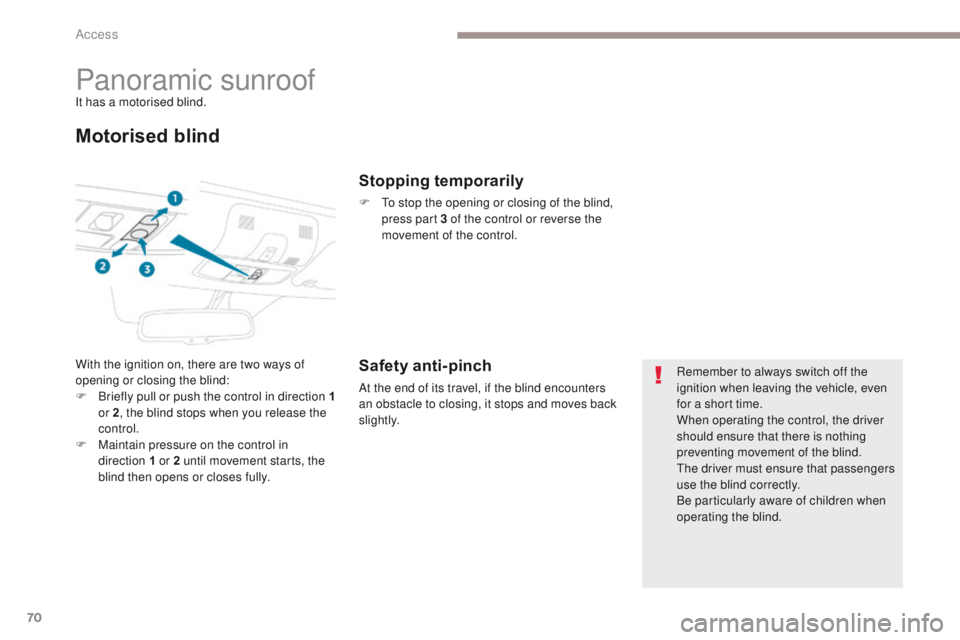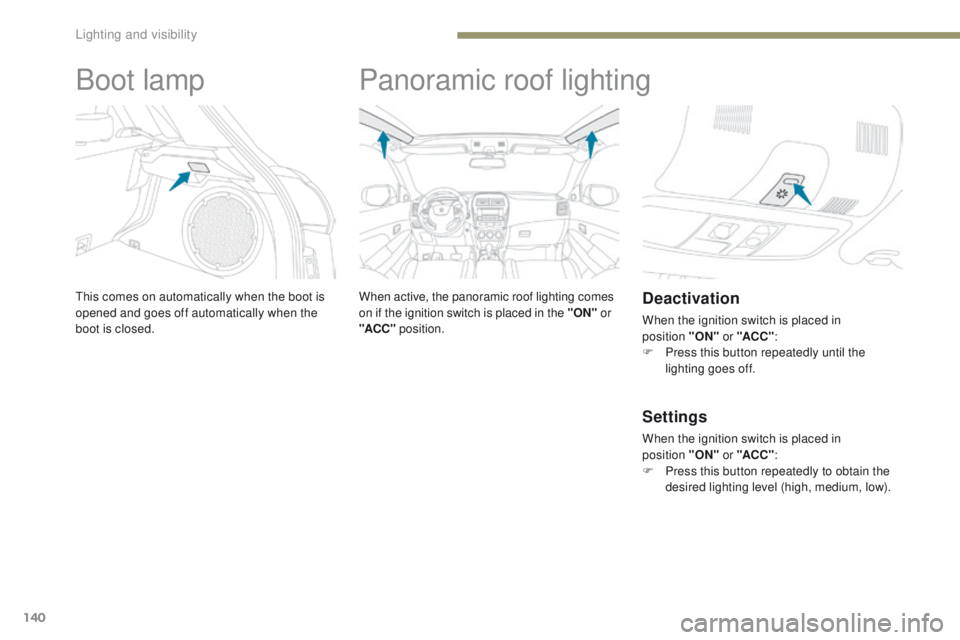2017 PEUGEOT 4008 roof
[x] Cancel search: roofPage 4 of 368

.
.
4008_en_Chap00a_sommaire_ed01-2016
Instrument panel 12
Warning and indicator lamps
1
3
Instrument panel screen
1
9
tr
ip computer
3
2
Distance recorder
3
2
tr
ip distance recorder
3
2
Service indicator
3
3
Adjusting vehicle settings
3
7
Audio- CD system screen
4
4
Audio- CD system touch screen
4
6
Audio-
te
lematic system
touch screen
4
8
Lighting dimmer
5
1Remote control key
5
2
"Keyless e
n
try and Starting"
system
5
6
Doors 62
Boot
6
3
Alarm
65
el
ectric windows
6
8
Panoramic sunroof
7
0
Front seats 7 1
Rear seats
7
4
Mirrors
76
Steering wheel adjustment
7
8
Ventilation
7
9
Manual heating / air conditioning
8
1
Automatic air conditioning
8
3
Front demist - defrost
87
R
ear screen demist - defrost
88
Interior fittings
8
9
Boot fittings
9
5Driving recommendations
9
7
Starting - switching off the engine with the key 98
S
tarting - switching off the engine with the Keyless
e
n
try and Starting system
9
9
Parking brake
1
02
Manual gearbox
1
03
ge
ar shift indicator
1
04
CV
t
gearbox
1
05
Hill start assist
1
10
Stop & Start (Auto Stop &
g
o
) system
1
11
Under-inflation detection
1
14
Four wheel drive system
1
18
Cruise control
1
20
Parking sensors
1
23
Reversing camera
1
26
Lighting controls
1
27
Daytime running lamps
1
30
Automatic illumination of headlamps
1
30
Manual guide-me-home lighting
1
31
Welcome lighting
1
32
Headlamp adjustment
1
33
Wiper controls
1
34
Automatic rain sensitive wipers
1
36
Courtesy lamps
1
38
Boot lamp
1
40
Panoramic roof lighting
1
40
Over view
e
co-driving
Instruments Access
ea
se of use and comfort Driving
Lighting and visibility
Contents
Page 5 of 368

.
4008_en_Chap00a_sommaire_ed01-2016
general safety recommendations 141
Direction indicators
1
42
Hazard warning lamps
1
42
Hor n
14
2
Braking assistance systems
1
43
tr
ajectory control systems
1
45
Front seat belts
1
47
Airbags
151
Child seats
1
56
Deactivating the passenger's front airbag
1
58
ISOFIX child seats
1
65
Child lock
1
71
Fuel tank
1
73
Snow chains
1
75
Automatic power cut-off to accessories
176
Changing a wiper blade
1
76
to
wing a trailer
1
77
Fitting roof bars
1
79
Bonnet
180
Petrol engines
1
81
Diesel engines
1
82
Checking levels
1
83
Checks
18
6te mporary puncture
repair kit 1 89
Changing a wheel
1
93
Changing a bulb
1
99
Changing a fuse
2
05
12 V battery
2
11
to
wing the vehicle
2
15
Running out of fuel (Diesel)
2
18
Petrol engines
2
19
Petrol weights
2
20
Diesel engines
2
25
Diesel weights
2
26
Dimensions
231
Identification markings
2
33Bluetooth® telephone with voice
recognition 23 5
to
uch screen A
uD
IO -
t
e
LeM
A
tI
C system
2
47
tOuC
H SCR
e
e
N AuD
IO - CD system
2
89
A
uD
IO - CD system
3
13
Safety
Practical information In the event of a breakdown
te
chnical dataAudio equipment and telematics
Alphabetical index
Contents
Page 6 of 368

4
4008_en_Chap00b_vue-ensemble_ed01-2016
exterior
Lighting controls 127-131
Headlamp beam adjustment 1 33
Welcome lighting
1
32
Changing bulbs
1
99-202
-
f
ront lamps
-
f
ront foglamps
-
d
irection indicator repeaters
W iper c ontrols
13
4 -137
Changing a wiper b l a d e
17
6
Door mirrors
7
6 -77
Doors
6
2, 64
-
ope
ning / closing
-
c
entral locking
Child lock
1
71
el
ectric windows
6
8 - 69
Alarm
65-67
Panoramic sunroof
7
0
Roof bars
1
79
Braking assistance
1
43-144
tra
jectory control
1
45-146
ty
re pressures
1
93, 233
un
der-inflation detection
1
14-117
Boot
63
-
ope
ning / closing
-
em
ergency release
te
mporary puncture
repair kit
1
89-192
Changing a wheel
1
93-198
-
tools
-
r
emoving / refitting
Snow chains
1
75
Changing bulbs
2
03-204
-
r
ear lamps
-
3rd brake lamp
-
n
umber plate lamps
-
foglamp
Parking sensors
1
23-125
Reversing camera
1
26
to
w b a r
17 7-178
to
wing
215 -217
Fuel tank
1
73
Remote control key /
electronic key
5
2-61
-
ope
ning / closing
-
a
nti-theft protection
-
battery
Over view
Page 8 of 368

6
4008_en_Chap00b_vue-ensemble_ed01-2016
Instruments and controls
Opening the bonnet 180
Door mirrors
7
6 -77
el
ectric windows
6
8 - 69Rear view mirror
7
8
Courtesy lamps
1
38 -139
Panoramic sunroof
7
0
Dashboard fuses
2
05 -207, 210
Instrument panel
1
2
Warning and indicator lamps
1
3-18
Indicators
33-35
Audio- CD system screen
4
4
Setting the time
4
4- 45
Audio- CD system touch screen
4
6
Setting the time
4
6 - 47
Audio-
te
lematic system
touch screen
4
8
Setting the time
4
9 -50
Parking brake
1
02
5/6-speed manual gearbox
1
03
ge
ar shift
indicator
104
CV
t g
earbox
10
5 -109
Hill start assist
1
10
4 wheel drive system
1
18 -119Audio- CD system
3
13 -336
Audio- CD touch screen system 28 9 - 312
Audio-te
lematic touch screen
system
247-288
Ventilation
79-80
Manual air conditioning
8
1-82, 87
Automatic air conditioning
8
3 - 87
Front demist - defrost
87
R
ear screen demist - defrost
8
8
Hazard warning lamps
1
42
Over view
Page 12 of 368

10
4008_en_Chap00c_eco-conduite_ed01-2016
eco-drivingeco-driving is a range of everyday practices that allow the motorist to optimise their fuel consumption and CO2 emissions.
Optimise the use of your gearbox
With a manual gearbox, move off gently and change up without waiting.
During acceleration, change up early.
With an automatic gearbox, give preference to automatic mode and
avoid pressing the accelerator pedal heavily or suddenly.
th
e gear shift indicator invites you to engage the most suitable gear:
as soon as the indication is displayed in the instrument panel, follow it
straight away.
For vehicles fitted with an automatic gearbox, this indicator appears
only in manual mode.
Drive smoothly
Maintain a safe distance between vehicles, use engine braking rather
than the brake pedal, and press the accelerator progressively. th ese
practices contribute towards a reduction in fuel consumption and CO
2
emissions and also help to reduce the background traffic noise.
Control the use of your electrical
equipment
Before moving off, if the passenger compartment is too warm, ventilate it
by opening the windows and air vents before using the air conditioning.
Above 30 mph (50 km/h), close the windows and leave the air vents
open.
Remember to make use of equipment that can help keep the
temperature in the passenger compartment down (sunroof, window
blinds, etc.).
Switch off the air conditioning, unless it has automatic regulation, as
soon as the desired temperature is attained.
Switch off the demisting and defrosting controls, if not automatic.
Switch off the heated seat as soon as possible.
Switch off the headlamps and front foglamps when the level of light
does not require their use.
Avoid running the engine before moving off, particularly in winter; your
vehicle will warm up much faster while driving.
As a passenger, if you avoid connecting your multimedia devices
(film, music, video game, etc.), you will contribute towards limiting the
consumption of electrical energy, and so of fuel.
Disconnect your portable devices before leaving the vehicle.
If your vehicle has cruise control, make use of the system at speeds
above 25 mph (40 km/h) when the traffic is flowing well.
eco-driving
Page 13 of 368

11
4008_en_Chap00c_eco-conduite_ed01-2016
Limit the causes of excess consumption
Spread loads throughout the vehicle; place the heaviest items in the
bottom of the boot, as close as possible to the rear seats.
Limit the loads carried in the vehicle and reduce wind resistance
(roof bars, roof rack, bicycle carrier, trailer, etc.). u
s
e a roof box in
preference.
Remove roof bars and roof racks after use.
At the end of winter, remove snow tyres and refit your summer tyres.
Observe the recommendations on
maintenance
Check the tyre pressures regularly, when cold, referring to the label in
the door aperture, on the driver's side.
Carry out this check in particular:
-
b
efore a long journey,
-
a
t each change of season,
-
a
fter a long period out of use.
Do not forget the spare wheel and the tyres on any trailer or caravan.
Have your vehicle serviced regularly (engine oil, oil filter, air filter,
passenger compartment filter, etc.) and observe the schedule of
operations recommended in the manufacturer's service schedule.
When refuelling, do not continue after the third cut-off of the nozzle to
avoid any over flow.
At the wheel of your new vehicle, it is only after the first 1 800 miles
(3
000 kilometres) that you will see the fuel consumption settle down to
a consistent average.
.
eco-driving
Page 72 of 368

70
4008_en_Chap02_ouvertures_ed01-2016
Panoramic sunroofIt has a motorised blind.
Motorised blind
With the ignition on, there are two ways of
opening or closing the blind:
F
B
riefly pull or push the control in direction 1
or 2 , the blind stops when you release the
control.
F
M
aintain pressure on the control in
direction 1 or 2 until movement starts, the
blind then opens or closes fully.
Stopping temporarily
F to stop the opening or closing of the blind, press part 3 of the control or reverse the
movement of the control.
Safety anti-pinch
At the end of its travel, if the blind encounters
an obstacle to closing, it stops and moves back
s li g ht l y. Remember to always switch off the
ignition when leaving the vehicle, even
for a short time.
When operating the control, the driver
should ensure that there is nothing
preventing movement of the blind.
the
driver must ensure that passengers
use the blind correctly.
Be particularly aware of children when
operating the blind.
Access
Page 142 of 368

140
4008_en_Chap05_Eclairage-et-visibilite_ed01-2016
Boot lamp
this comes on automatically when the boot is
opened and goes off automatically when the
boot is closed.
Panoramic roof lighting
When active, the panoramic roof lighting comes
on if the ignition switch is placed in the "ON" or
"ACC " position.Deactivation
When the ignition switch is placed in
position "ON" or "ACC ":
F
P
ress this button repeatedly until the
lighting goes off.
Settings
When the ignition switch is placed in
position "ON" or "ACC ":
F
P
ress this button repeatedly to obtain the
desired lighting level (high, medium, low).
Lighting and visibility